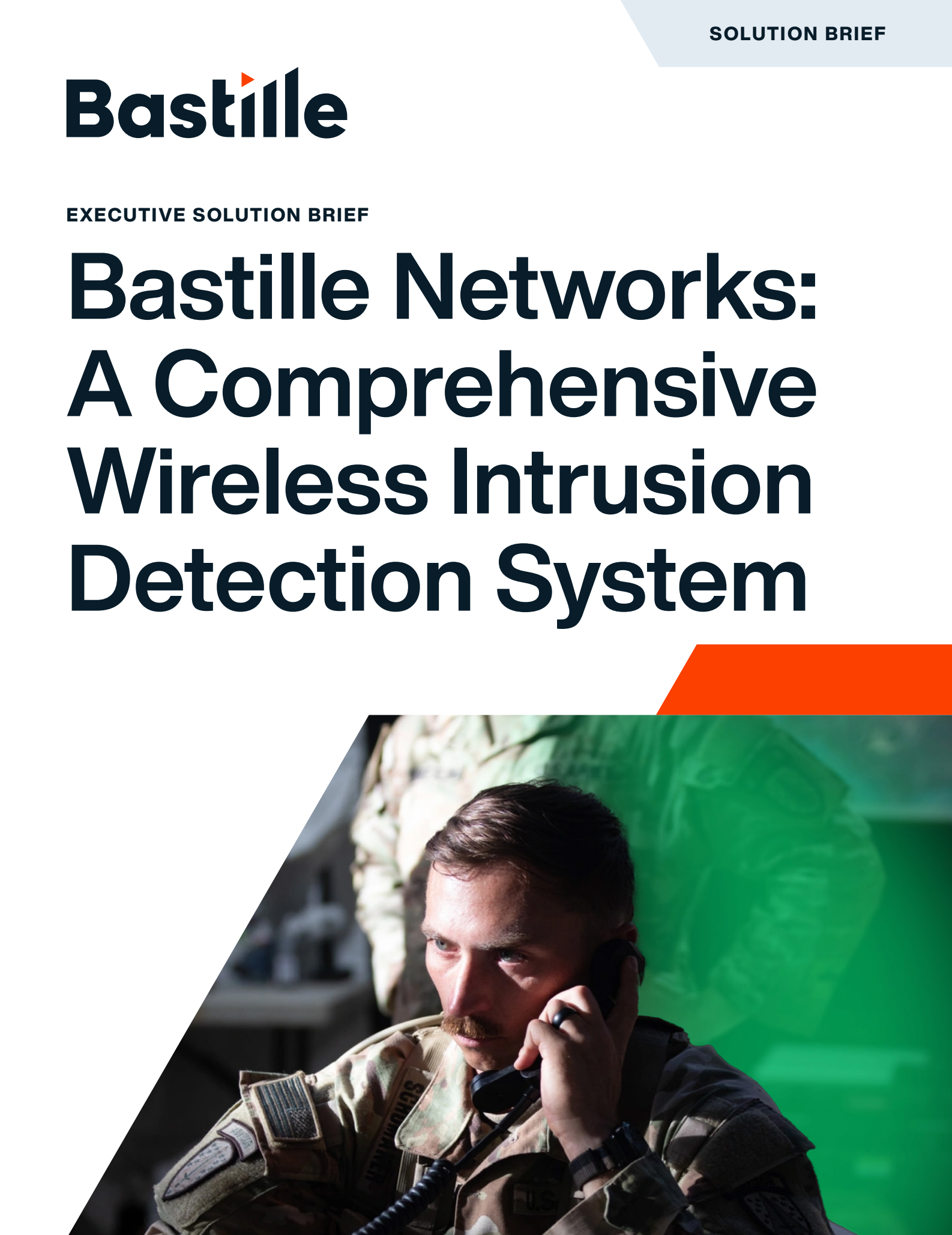
Table of Contents
Introduction: Why Wireless Threats Are SCIF-Grade Risks
Sensitive Compartmented Information Facilities (SCIFs) maximize security to control access to classified or sensitive information. Security personnel monitor every physical entry, install shielding to block extraneous signals, and screen for all devices entering secure areas. Yet, the most serious threats to a SCIF may not enter through a door; they may penetrate wirelessly.
As federal operations increasingly rely on digital technologies, the threat landscape extends into the airspace. A Wireless Intrusion Detection System (WIDS) is no longer a luxury but a necessity, providing the visibility needed to detect and respond to radio frequency (RF)-based threats in real time.
Understanding WIDS: What It Is and Why SCIFs Need It
WIDS is a security solution purpose-built to detect, locate, and alert on unauthorized wireless transmissions. Unlike conventional IT security controls, it passively monitors the RF spectrum, capturing signals across:
- Wi-Fi
- Bluetooth and Bluetooth Low Energy (BLE)
- IoT Protocols (Zigbee, DECT, and others)
- Cellular (4G, 5G, LTE)
For SCIFs, WIDS is essential for:
- Identifying unauthorized devices
- Detecting shielding leaks
- Enforcing no-wireless policies continuously
Without WIDS, SCIFs remain blind to RF threats within their controlled environments.
SCIF Vulnerabilities: Where Traditional Security Falls Short
Despite robust security postures, SCIFs remain vulnerable due to limitations in traditional controls:
- Degraded or misapplied shielding
- Unintentional introduction of wireless devices by personnel
- Illicit device placement during low-occupancy periods
- Automatic transmissions from Bluetooth or BLE devices
Standard IT and physical security systems cannot detect these exposures. A dedicated RF monitoring layer must address these blind spots without disrupting the facility’s operational integrity.
Common Wireless Threats in Sensitive Compartmented Facilities
WIDS addresses a variety of RF-based risks, including:
| Threat Type | Description |
| Bluetooth Beacons | Emissions from wearables or smartphones in restricted zones |
| Rogue Access Points | Devices masquerading as authorized SCIF networks |
| Zigbee or IoT Devices | Embedded or tampered smart devices left behind |
| RF Leakage | Signal escape through physical shielding |
| Jamming Attacks | Attempts to interfere with SCIF communications or surveillance tools |
The Role of WIDS in SCIF Policy Enforcement
Security policies banning wireless devices require constant validation. WIDS enables SCIF managers to:
- Monitor for live RF transmissions within restricted areas
- Receive real-time alerts when violations occur
- Maintain historical logs for audits and investigations
- Support automated enforcement of custom RF restrictions
WIDS reinforces accountability and compliance through continuous monitoring.
The Cost of RF Blind Spots in Classified Environments
Neglecting RF visibility can result in:
- Delays or denials in achieving Authority to Operate (ATO)
- Regulatory penalties and investigations
- Reputational harm and loss of stakeholder trust
- Compromised mission effectiveness
- Clearance risks for involved personnel
The investment in RF detection capabilities is minor compared to the potential cost of a breach.
Combining WIDS with Wireless Discovery and Inventory
WIDS capabilities are significantly enhanced when paired with asset discovery tools that:
- Inventory all wireless-capable devices in real time
- Track authorized and transient transmitters
- Identify unknown or rogue emissions
- Maintain a validated baseline of permitted RF assets
This combined approach delivers robust airspace control across the facility lifecycle.
Bastille’s WIDS Platform for SCIF Environments
Bastille offers a full-spectrum Wireless Intrusion Detection System for classified federal facilities, including SCIFs. Key features include:
- Passive monitoring across a broad RF spectrum (100MHz to 7.125GHz)
- Real-time visibility into hundreds of simultaneous frequencies
- Location of devices through zone-based RF localization
- Integration with SIEM and SOAR platforms
- Deployment that requires no network interference or agent installation
Bastille’s WIDS also supports compliance with key federal standards such as CNSSI 1253 and NIST SP 800-53 by addressing controls like:
- SI-4 (System Monitoring) – Continuous RF visibility
- PE-20 (Visitor Control) – Unauthorized device detection during visitor access
- AC-19 (Wireless Access Control) – Enforcement of wireless zoning policies
- CM-8 (System Component Inventory) – Inventory of RF-emitting devices
Operational Example: Bastille in a Federal SCIF
A U.S. intelligence agency implemented Bastille WIDS after an audit identified shortcomings in wireless device tracking. Shortly after deployment, the platform identified BLE activity from a fitness tracker that had evaded entry checks. The device was removed, and data logs informed changes to visitor protocols. The deployment transformed a policy gap into a compliance success.
Bastille’s Zone-Based RF Localization
Bastille WIDS delivers room-level localization through:
- Mapping device location with 1-meter accuracy through patented technology
- Assigning severity by zone classification
- Maintaining visibility across large or multi-zone SCIFs
This approach enables rapid, targeted response without compromising operations.
Device Discovery, Alerts, and Audit Logging
Bastille strengthens SCIF operations through:
- Real-time alerts via integrations with SIEM systems
- Device transmission metadata collection and correlation
- Historical logs for investigations and compliance reviews
- Exportable reporting for auditing and regulatory response
Bastille provides a complete solution, from detection to documentation.
Deployment Simplicity
Bastille’s WIDS offers:
- Passive operation – No signal emission
- Scalability – Suitable for SCIFs of any size
- Non-invasiveness – No agent installation or user involvement required
- Integration-readiness – Compatible with access control and security infrastructure
- Simple user experience – No need for RF-knowledgeable personnel to operate
Bastille delivers operational security without operational friction.
Conclusion: WIDS as a Foundation of SCIF Integrity
In today’s RF-rich threat environment, SCIFs cannot rely solely on traditional controls. Airspace visibility is a critical pillar of secure operations. Wireless Intrusion Detection Systems provide the insight required to safeguard sensitive environments against unauthorized transmissions. By integrating WIDS into SCIF operations, facility managers strengthen policy enforcement, streamline compliance, and reduce risk across the board.
Bastille’s Wireless Intrusion Detection System delivers the precision, compliance, and visibility that classified environments demand. It doesn’t just protect the SCIF; it protects the mission, data, and future.
Learn more about how Bastille supports airspace security for federal and classified facilities:
Bastille Wireless Intrusion Detection
FAQs About WIDS for SCIFs
What is a Wireless Intrusion Detection System (WIDS), and how does it work in a SCIF?
Within a SCIF, WIDS passively monitors the RF spectrum to identify unauthorized wireless transmissions, including signals from Bluetooth, Wi-Fi, IoT, and cellular devices that could compromise security.
Why is WIDS necessary for SCIF security?
Wireless signals can bypass physical and administrative controls. WIDS provides real-time detection and response, enabling SCIF operators to maintain strict wireless airspace integrity.
Can WIDS detect personal devices like smartphones or wearables in a SCIF?
Yes. Advanced WIDS platforms can detect and identify personal wireless devices, even if they are not connected to any network.
Is using WIDS in a SCIF compliant with CNSSI 1253 and NIST standards?
Yes. Through continuous monitoring, zoning enforcement, and logging, WIDS supports multiple compliance frameworks, including CNSSI 1253 and NIST SP 800-53.
How does Bastille WIDS locate the source of a wireless threat inside a SCIF?
Bastille’s platform uses patented technologies to locate wireless transmitters within 1 meter accuracy. It is the only solution that accurately tracks Bluetooth and BLE devices before and after pairing.

